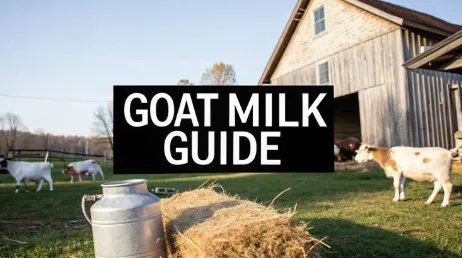
A Homesteader's Guide to Raising Goats for Milk
A Homesteader's Guide to Raising Goats for Milk
Thinking about bringing dairy goats onto your homestead? It's one of those decisions that changes things—in a good way. You get a real connection to your food, a pail full of fresh, delicious milk, and a deeper sense of self-sufficiency. This isn't just another chore; it's a lifestyle that grounds you.
Why Start Your Journey with Dairy Goats
Jumping into dairy goats is a huge step toward a more self-reliant way of living. It’s your chance to really understand where your food comes from and have total control over its quality. Beyond that, the simple rhythm of daily care and milking creates a bond and a routine that many of us find surprisingly peaceful and fulfilling.
The perks go far beyond just the milk itself. Fresh goat milk is often easier to digest than cow's milk because it's naturally homogenized, making it a solid choice for families with mild dairy sensitivities. Plus, you can turn that milk into an incredible variety of foods right in your own kitchen.
The Rewards of Homestead Dairy
Picture this: creamy chèvre, tangy yogurt, or rich ice cream, all made from milk that came from just a few steps outside your back door. Those are the tangible rewards that make the early mornings and daily chores completely worth it. The pride that comes from producing your own food is something you just can't buy.
It's also a fantastic learning experience for the whole family, teaching responsibility, animal husbandry, and the cycles of nature. Goats are characters, too. With their curious and affectionate personalities, they often feel more like pets than livestock. If you're looking for animals that are relatively straightforward to manage, you might find our guide on the best low-maintenance homestead animals for beginners helpful.
Understanding the Commitment
Before you bring home your first kids, it’s critical to get real about the investment of time, money, and space. Raising goats for milk isn't a weekend project; it's a daily promise. You need to be there for morning and evening milkings, feedings, and regular health checks, day in and day out.
This chart gives you a snapshot of the key commitments you'll need to plan for.
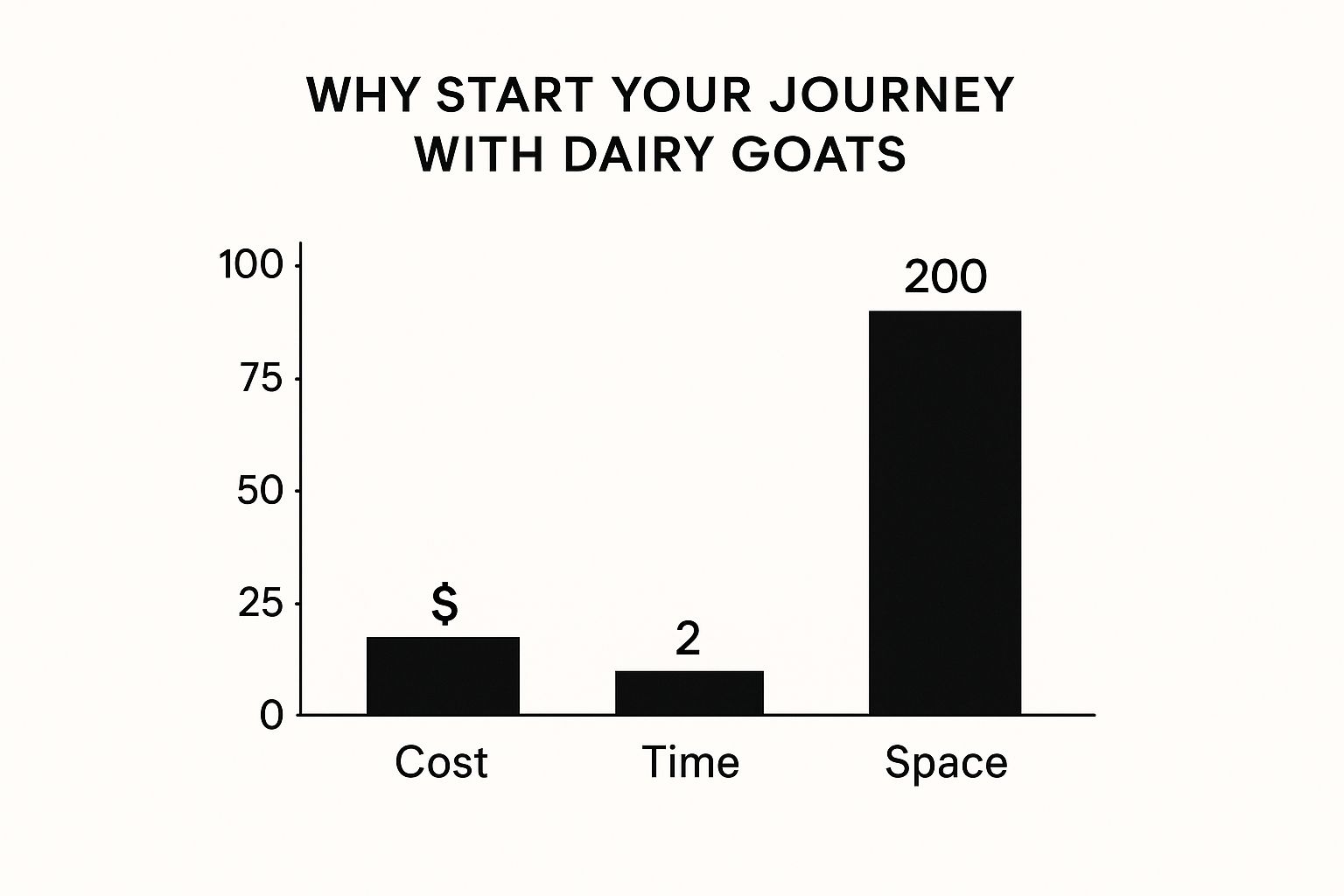
It lays out the upfront costs and what you can expect for ongoing space and time per animal. This helps you budget not just your finances, but also your daily schedule and how you'll lay out your property.
The growing interest in goat milk isn't just a homesteading trend; it shows a wider appreciation for its benefits. In fact, worldwide goat milk production has shot up from just over 6 million tons in 1970 to over 20 million tons in 2023. That’s more than triple!
This commitment is a two-way street. The care you provide directly translates into the health of your herd and the quality of the milk you receive. Starting with a clear understanding of these responsibilities is the key to a successful and enjoyable experience.
Choosing the Right Dairy Goat Breed
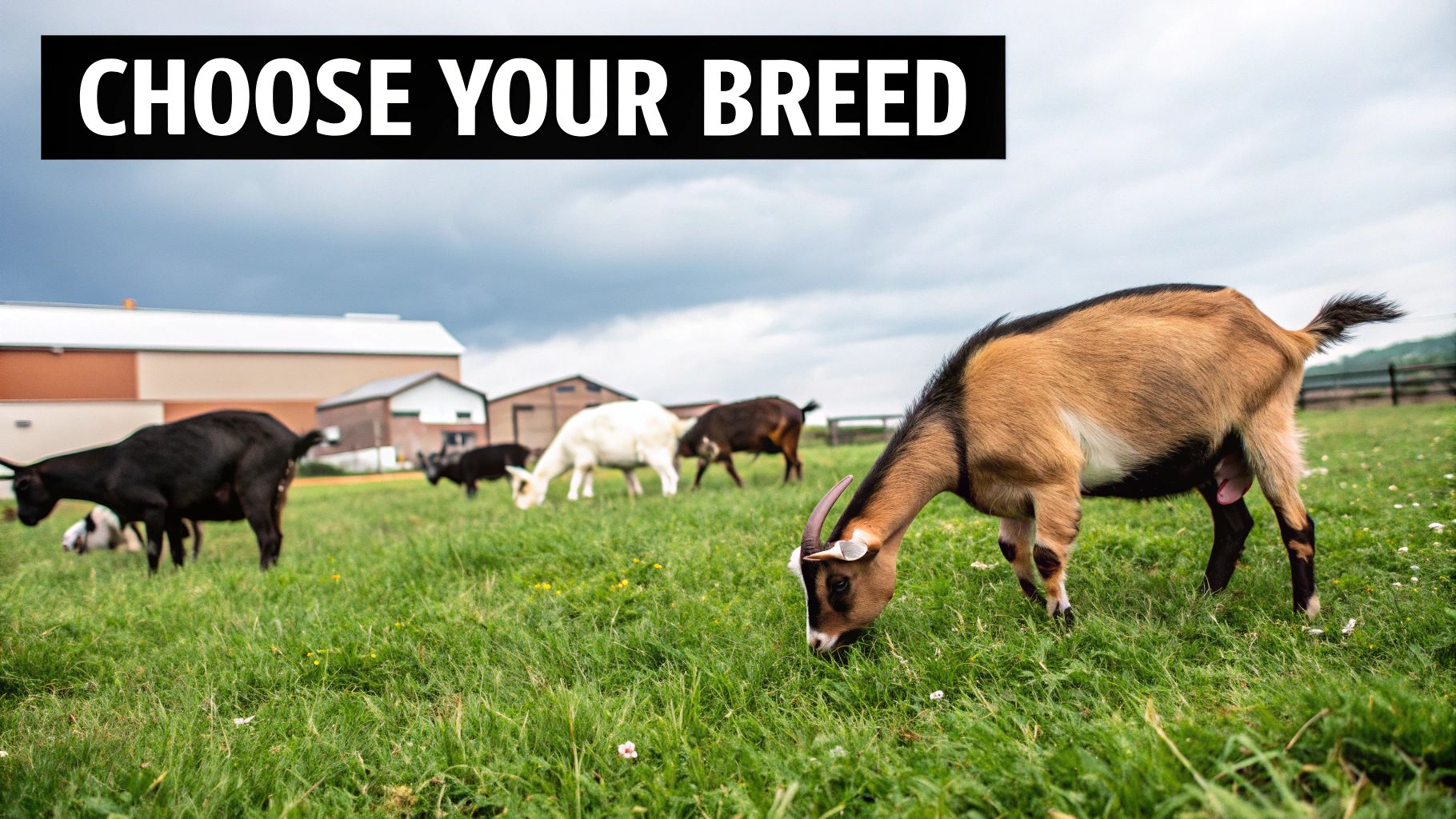
Picking your first dairy goat is one of the most important decisions you'll make. It sets the tone for everything—your daily chores, the milk you'll get, and what you can make with it in your kitchen. This isn't just about choosing a pretty face at the farm gate; it's about matching an animal's personality, milk profile, and needs to your own homestead goals.
Every breed brings something unique to the milking stand. Some goats are famous for producing gallons of milk a day, perfect for a big family. Others are prized for milk so rich and creamy it's practically liquid cheese. Getting this distinction right from the start is the key to success.
Volume vs. Butterfat: A Crucial Distinction
When you're raising goats for milk, the biggest thing to wrap your head around is the trade-off between milk volume and butterfat content.
Think of it this way. High-volume breeds like Alpines and Saanens are your marathon runners. They consistently churn out a huge amount of milk every single day. If your main goal is having plenty of fresh milk to drink, these are fantastic choices.
On the other hand, you have breeds like Nigerian Dwarfs and Nubians. They might produce less milk overall, but what they give is incredibly rich in butterfat—the essential fats and proteins that make for amazing dairy products.
If you dream of making creamy chèvre, thick yogurt, or luxurious goat milk soap, high butterfat content is non-negotiable. The higher the butterfat, the greater your yield and the richer your final product will be.
So, the first question to ask yourself is: why do I want fresh milk? Your answer will point you straight to the right kind of goat.
Meet the Top Dairy Goat Contenders
While there are dozens of wonderful dairy breeds out there, a few really shine on a homestead. Each has its own mix of size, temperament, and milk that fits different situations. For a deeper look into the fundamentals of goat care, our complete guide on how to raise goats is a great place to start.
Let's break down some of the most popular choices:
Nigerian Dwarf Goats: These little goats are perfect for smaller properties. What they lack in size, they more than make up for with incredibly high butterfat, often hitting 6% to 10%. Their milk is sweet and creamy, making them the undisputed champions for home cheesemakers.
Nubian Goats: Often called the "Jersey cows of the goat world," Nubians are famous for their long, floppy ears and wonderfully loud personalities. They strike a great balance, producing a good amount of milk with a high butterfat content (around 5%). This makes them a fantastic, all-around choice.
Alpine Goats: Hailing from the French Alps, these goats are hardy, curious, and incredible milk producers. As a high-volume breed, they can consistently give a gallon or more per day, though the butterfat is lower (around 3.5%). They're an ideal pick if your family goes through a lot of drinking milk.
Matching a Breed to Your Homestead
The stats on paper are one thing, but how a goat fits into your life is what really matters. You have to consider your property size, your climate, and even your own personality.
Here’s a real-world example: A family on a quarter-acre in the suburbs wants to make their own cheese. A pair of large Alpine goats would feel cramped and probably get into trouble. But two or three Nigerian Dwarf does? They would thrive in that space, giving them more than enough rich milk for cheesemaking without taking over the whole yard.
Now, picture a family on several acres aiming to be self-sufficient in milk. A small herd of Alpines or Saanens would be a perfect fit. Their high volume ensures a steady supply for drinking, and their hardy nature makes them well-suited for larger pastures.
Dairy Goat Breed Comparison for Homesteaders
To make things a little clearer, here’s a simple table to help you compare these popular breeds side-by-side. Think about your land, your goals, and how much interaction you want with your animals.

Ultimately, choosing the right breed comes down to being honest with yourself. When you align a goat's natural traits with your homestead's capacity and your personal goals, you're setting yourself up for a truly rewarding journey.
Designing a Safe and Practical Goat Shelter
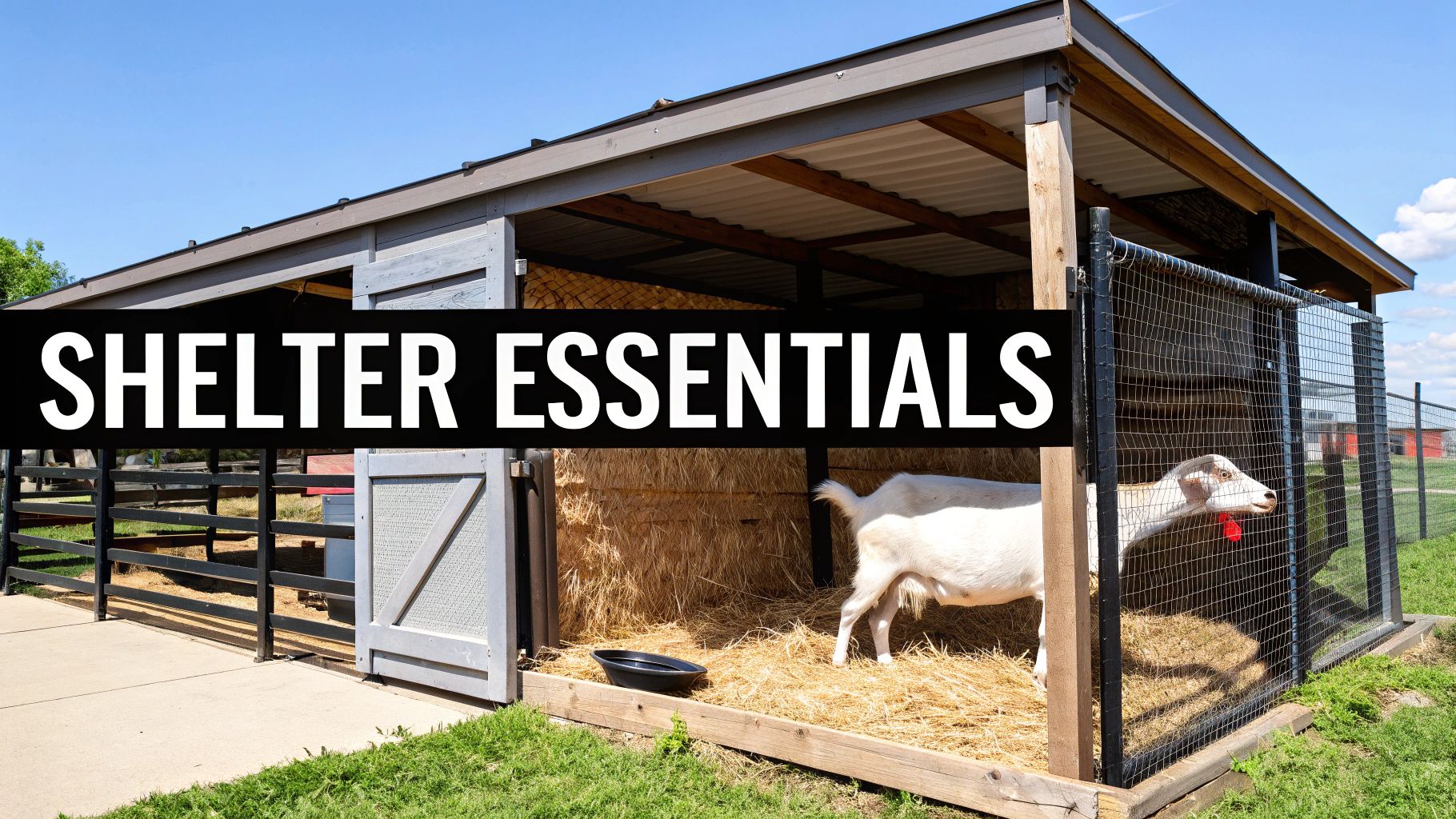
A healthy, productive dairy goat herd starts with a good home. When you're raising goats for milk, their shelter is more than just a barn—it's their sanctuary from weather, predators, and stress. A well-designed space doesn't just keep them safe; it makes your daily chores a whole lot easier, too.
Goats are tougher than they look, but they absolutely hate being wet and drafty. More often than not, a simple three-sided structure that blocks the prevailing wind and rain is all they need. It doesn't have to be fancy, but it has to be dry and clean to head off health issues that can tank your milk production.
Shelter Essentials for Healthy Goats
The single most important part of any goat shelter is ventilation. Stale, damp air is a breeding ground for respiratory illnesses like pneumonia, which can be a disaster for a milking doe. Good ventilation gets the moist air out without creating a cold, direct draft on your animals.
Think of it like this: you want airflow high above where the goats bed down, letting fresh air circulate while they stay cozy below. Vents near the roofline or even just a gap between the walls and the roof are simple ways to make this happen.
The other non-negotiable is dry bedding. Standing on damp ground is a fast track to hoof rot, a painful condition that will immediately impact a goat’s well-being and milk supply. You'll need a thick layer of something clean and absorbent, like pine shavings or straw.
A "deep litter method" can be a game-changer for many homesteaders. By continuously adding fresh bedding on top of the old, you create a composting layer that generates a small amount of heat, keeping the shelter warmer in winter while also managing waste effectively.
Calculating Your Space Requirements
Overcrowding is a huge source of stress for goats. That stress can suppress their immune systems and send milk output plummeting. Giving them enough personal space is one of the easiest ways to keep the peace and maintain a healthy herd dynamic.
Here’s a practical breakdown of what you'll need:
Shelter Space: Plan for at least 15-20 square feet of sheltered space per standard-sized goat (like a Nubian or Alpine). For smaller breeds like Nigerian Dwarfs, 10-15 square feet is usually plenty.
Pasture or Dry Lot: Each goat needs a minimum of 200-250 square feet of outdoor space just to stretch their legs. More is always better, as it cuts down on parasite load and gives them room to browse.
These numbers are just a starting point. If you live in a place with harsh winters where your goats will spend more time indoors, you'll want to lean toward the higher end of these recommendations. It's a smart move.
Fencing and Predator Proofing
Goats are smart, curious, and notoriously good at escaping. Your fencing is one of the most important investments you'll make. It’s not just about keeping your herd in—it's just as much about keeping predators out.
Choosing the right type of fencing can be a tough call. Let's look at two of the most popular options.

A lot of homesteaders end up using a combination of the two: a secure woven wire perimeter fence with electric netting inside to create smaller, rotational grazing paddocks. This setup gives you both top-tier security and the flexibility to manage your pastures well.
Whatever you choose, make sure your fencing is at least four feet high—goats are excellent jumpers. And don't forget to secure the base of the fence against the ground. It's vital for stopping predators from digging their way in.
Your Guide to Goat Nutrition and Health
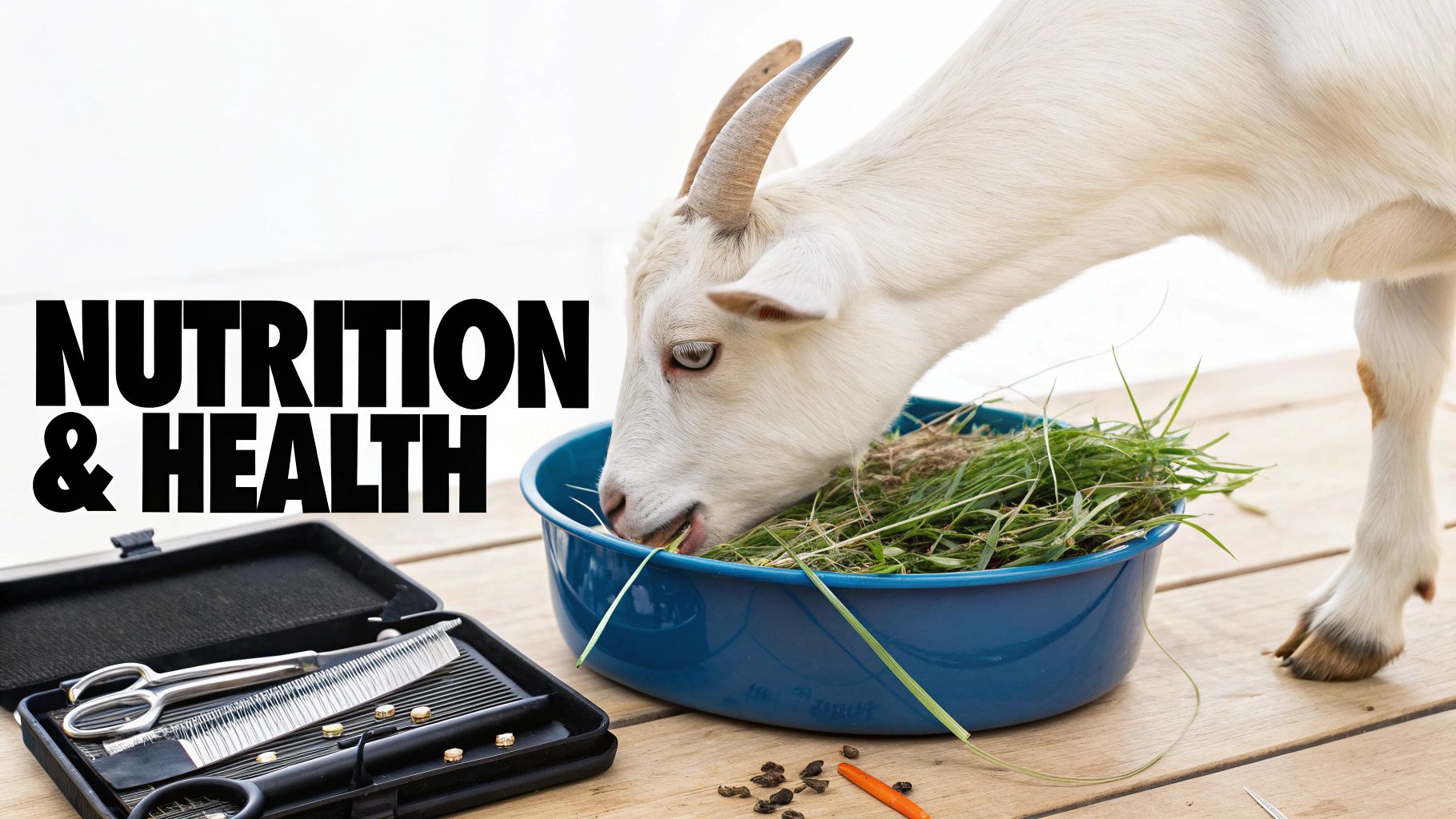
If you want healthy, productive dairy goats, it really boils down to two things: what you feed them and how you look after them. What goes into your goats has a direct line to the quality—and quantity—of the milk that comes out. A happy, well-fed doe is a productive doe, which makes mastering her diet and health one of the most important jobs you have.
The foundation of a solid goat diet isn’t some fancy grain mix or pricey supplement. It’s high-quality forage. Goats are ruminants, built with a complex digestive system designed specifically to break down fibrous plants. That makes excellent hay or pasture the absolute cornerstone of their daily nutrition.
Building a Balanced Diet for Dairy Goats
A doe in milk has incredible nutritional needs. She isn’t just eating for herself; she’s turning feed into quarts, or even gallons, of nutrient-dense milk every single day. Her diet has to be precisely balanced to support this amazing biological feat without running her own body down.
Forage should make up the bulk of what she eats. Think high-quality alfalfa or a good grass-hay blend. Alfalfa is a real powerhouse for milking does because it’s packed with both protein and calcium—two things she desperately needs for milk production.
But forage alone often can't provide enough concentrated energy for a lactating doe. That's where a balanced dairy goat grain ration comes in. It’s not a treat; it’s a necessary tool to meet the intense caloric demands of making milk. Look for a feed with around 16% protein.
A classic mistake is giving too much grain and not enough quality hay. This can throw their whole digestive system out of whack. Always introduce feed changes slowly and make sure they have free-choice access to good hay and loose minerals formulated specifically for goats.
It seems the rest of the world is catching on to the benefits of goat milk, too. The global market for goat dairy was valued at USD 90.30 billion in 2024 and is projected to hit USD 158.6 billion by 2032, driven by things like easily digestible infant formulas. You can dig deeper into these numbers by checking out the full goat dairy products market report.
A Practical Health Management Calendar
Trust me, preventative care is always easier, cheaper, and far less stressful than dealing with a sick animal. Setting up a simple, repeatable health schedule is one of the best things you can do for your herd. It keeps you on track and helps you spot little problems before they blow up.
Here’s a sample schedule you can tweak for your own homestead:
Monthly Hoof Trimming: Overgrown hooves can cause lameness and discomfort, which kills milk production. Regular trims keep your goats comfortable and on their feet.
Parasite Management as Needed: Instead of deworming on a rigid schedule, it's better to work with your vet to run fecal tests. This lets you treat for specific parasites only when you need to, which helps prevent drug resistance.
Annual Vaccinations: Chat with a local vet to figure out the best vaccination plan for your area. The most common one is the CDT vaccine, which protects against overeating disease and tetanus.
Spotting Early Signs of Illness
Your best diagnostic tool is your own two eyes. When you spend time with your goats every day, you learn their normal quirks and behaviors. That makes it so much easier to tell when something is off. A goat that’s off her feed, standing alone, or has a dull coat is trying to tell you something isn't right.
For a milking doe, keeping an eye on her udder is critical. Mastitis, an infection of the udder, is a common problem that can quickly end a doe's milking career if you don't catch it early.
Check for these red flags every time you milk:
Heat or Swelling: The udder feels unusually warm to the touch, hard, or looks swollen.
Abnormal Milk: You see clots, strings, watery milk, or even blood.
Pain or Discomfort: The doe flinches when you touch her udder or fights you during milking.
Using a strip cup to check the first few squirts of milk is a simple but incredibly effective way to screen for mastitis before it becomes a full-blown crisis.
Assembling Your Goat First-Aid Kit
When something does go wrong, being prepared can make all the difference. You don't need a vet's entire pharmacy on hand, but a well-stocked first-aid kit lets you handle minor issues with confidence and stabilize an animal until help can arrive.
Your kit should have the basics like wound cleaner (chlorhexidine or iodine), gauze, vet wrap, a digital thermometer, and electrolytes. It's also smart to have blood stop powder and your hoof trimming tools ready to go. Having these simple things organized and accessible gives you peace of mind and makes you a much more effective caretaker for your herd.
Mastering Your Milking Routine
This is it. This is where all your hard work pays off—in a pail of fresh, creamy milk. Getting your milking routine down is the key to success. It’s not just about the mechanics; it's about creating a calm, consistent experience that your doe comes to trust, ensuring a good milk let-down every single time.
A predictable schedule is your best friend here. Goats are creatures of habit. They thrive on knowing what comes next. Milking twice a day, roughly 12 hours apart, keeps their production steady and their udders comfortable. A dedicated, clean space for milking, like a simple stanchion or stand, signals to your doe that it's time to get to work.
Preparing for a Clean Milking Session
When it comes to milk quality and udder health, sanitation is everything. A single speck of dirt or hair in the pail can affect the flavor and introduce bacteria. Before you even bring your doe to the stand, get your clean supplies gathered and ready.
Here’s what you’ll need on hand:
A seamless stainless steel pail: These are a breeze to sanitize and won't hold onto old odors. I like to chill mine in the freezer beforehand to help cool the milk down fast.
Warm, soapy water and a clean cloth: For washing the udder. A gentle soap like castile works perfectly.
A strip cup: This is just a small cup with a mesh screen. It lets you check the first few squirts of milk for any clumps or strings, which can be an early sign of mastitis.
A post-milking teat dip: An essential step that helps protect the open teat from bacteria after you’re done milking.
Once your doe is comfortably on the stand enjoying her grain, gently wash her udder and teats with the warm water, then dry them completely with a separate clean cloth. This simple step doesn't just clean the area—it also helps stimulate milk let-down.
Hand Milking vs. Machine Milking
For most homesteaders, the choice between hand and machine milking comes down to how many goats you have, your budget, and what you prefer.
Hand milking is a timeless skill. It creates a real connection with your animals, requires no electricity, and has almost no upfront cost. But it takes some practice to get the technique right, and it can be tough on your hands and wrists, especially if you have several goats to milk every day.
A milking machine, on the other hand, can be a total lifesaver for folks with larger herds or physical limitations. It's much faster and provides consistent suction. The trade-offs are the higher initial cost and a more involved cleaning process after every use.
No matter which method you choose, the goal is the same: empty the udder completely and gently. This signals her body to keep producing milk and is one of the best ways to prevent issues like mastitis.
Handling and Storing Your Milk
The moment milk leaves the udder, the clock starts ticking on its freshness and flavor. What you do in that first hour is critical. The absolute key is to chill it as quickly as possible.
Rapid chilling is what prevents that "goaty" flavor some people worry about. That taste is caused by the breakdown of fatty acids, a process that slows way down at cold temperatures. After milking, strain the milk through a fine filter into clean glass jars.
Immediately place those jars into an ice bath or the freezer for about an hour to bring the temperature down fast. Once the milk is thoroughly chilled, move it to the coldest part of your refrigerator. Handled this way, fresh goat milk can easily last for a week or more.
The demand for high-quality goat milk products is growing, too; the global market was valued at USD 13.75 billion in 2024 and is expected to climb. This just shows how valuable it is to produce excellent milk right on your own homestead. You can find more details about these market trends online.
Once you have a steady supply, you can start experimenting with other homestead dairy projects. Our guide on making butter from whole milk is a fantastic next step. I also recommend keeping a simple record of each doe's milk volume—it helps you track her production curve, which is an essential indicator of her overall health and lactation cycle.
Common Questions About Raising Dairy Goats
When you're just getting started with dairy goats, you're going to have questions. Everyone does. Let's walk through some of the most common ones that pop up for new homesteaders, with some straight-to-the-point advice to get you on the right track.
How Much Milk Can I Expect From One Goat?
This is the big question, and the honest answer is: it depends. A whole lot. Milk production hinges on the goat's breed, her age, what she’s eating, and where she is in her milking cycle.
A smaller goat like a Nigerian Dwarf might give you about a quart of incredibly rich, high-butterfat milk each day. On the flip side, a full-sized production breed like an Alpine or Saanen can easily top a gallon or more daily when they're at their peak.
Milk supply isn't a flat line; it follows a natural curve. A doe usually hits her peak production a couple of months after giving birth (kidding) and then will slowly taper off. A typical lactation lasts around 10 months. Scribbling a few notes on a calendar will quickly teach you the unique rhythm of each doe in your herd.
A quick heads-up: don't get discouraged if your first-freshener (a doe who has kidded for the first time) isn't a superstar producer. It's totally normal for a doe's milk supply to increase with each lactation as her body matures.
Do I Need a Buck to Get Milk?
This is a classic point of confusion for beginners. The short answer is yes... and no. A doe has to be bred and give birth to start producing milk, so you absolutely need a buck for that part.
But you don't necessarily have to own one.
Lots of small homesteads choose to skip keeping a buck full-time. They can have a seriously powerful odor, need their own tough-as-nails housing, and can sometimes be aggressive. Instead of dealing with all that, you have options:
Leasing a Buck: Find a reputable local breeder who will let you "borrow" their buck for breeding season.
"Driveway Breeding": This is exactly what it sounds like. You take your doe to the buck's farm for a date when she's in heat.
Artificial Insemination (AI): A great option that lets you access top-tier genetics from all over the country without any of the buck-related headaches.
What Are the Biggest Mistakes New Goat Owners Make?
Everyone makes mistakes—it’s just part of the learning curve. But you can save yourself a lot of grief by sidestepping a few common pitfalls right from the start.
Getting Only One Goat: This is a big one. Goats are intensely social herd animals. A single goat will be a lonely, stressed-out, and probably very loud goat. Always, always start with at least two.
Underestimating Fencing Needs: Goats are Houdinis with hooves. Flimsy, short fencing isn't a barrier; it's a fun challenge. You have to invest in proper, goat-specific fencing from day one. Don't skimp here.
Waiting for an Emergency to Find a Vet: Not all vets know their way around a goat. Your best move is to find a local large-animal vet who treats goats and build a relationship before you have a sick animal. That connection is priceless when you actually need it.
Can I Make Cheese or Yogurt From My Goat Milk?
Absolutely! Honestly, this is one of the most rewarding parts of the entire adventure. Goat milk is a dream to work with for all kinds of home dairy projects.
Its unique chemical structure, especially the high butterfat content you get from Nigerian Dwarfs and Nubians, creates unbelievably creamy and flavorful products. You can easily whip up your own chèvre, feta, yogurt, kefir, and even caramel sauce (cajeta). The process is a lot like using cow's milk, but the end result has a delightful, tangy character that is all its own.
At The Grounded Homestead, we're passionate about helping you connect with your food and build a more self-sufficient life. Explore our other guides and resources to continue your homesteading journey at https://thegroundedhomestead.com.


Facebook
Instagram
X
Youtube